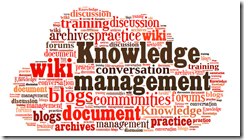 Traditionally, knowledge management has been considered as a discipline to classify documents, archive them and hope that in the future someone might want to locate them. Over the last few years, the classic concepts and models such as the Data-Information-Knowledge [and Wisdom] are being superseded by newer business and organizational models.
Traditionally, knowledge management has been considered as a discipline to classify documents, archive them and hope that in the future someone might want to locate them. Over the last few years, the classic concepts and models such as the Data-Information-Knowledge [and Wisdom] are being superseded by newer business and organizational models.
The need for instant gratification expectation and the sense of urgency that most of us have, having tons of documents, even if classified adequately, is not immediately useful.
Consider a Project manager, preparing a new project plan and needs to identify the potential high risks. Asking this person to go through a few dozen [if not hundreds] of documents and cull out the risks relevant to the specific context, is very unlikely to be taken up.
On the other hand, if the person is able to characterize the project under question broadly and has a facility to narrow down the search to those projects that are similar, chances of extracting something of closer benefit will be higher.
This introduces the need for viewing the knowledge needs in an organization at multiple levels.
From a top down perspective, based on the strategic goals, organization structure and initiatives, there is a need for a high level classification – which I would like to call as the Hi-Tax [or high level taxonomy].
But, at a practitioner level, be it individual or team [or, in some cases an organizational unit], what is more relevant is a taxonomy in the context [was trying to avoid another jargon – ontology!], which I would like to call Lo-Tax – or localized taxonomy.
How are these relevant for an organizational excellence journey?
Having these two tiers of taxonomies and maps to view the knowledge nuggets as needed, will greatly simplify the just in time learning and also help prevent same mistakes being repeated, based on past experience that is interpret in the context.
As in the D-I-K-W model, the raw data – these days it is BIG data! – gathered from various systems of record in the organization needs to be classified – analyzed – in the context when the data was captured.
This contextual information can include people, process / systems prevalent at that time as well as technology and business architectures.
For instance, let us take an initiative to improve the process times for internal approvals. The time spent in follow-ups is one of the large chunks of a project manager’s time. How can a knowledge management approach help in this?
Let us imagine a situation where the data from the internal ERP or other workflow systems can be analyzed for patterns : such as the most common causes for rejection or reverts of purchase requests, say by type of request or by specific managers.
This analyzed data [Information] can be overlaid on a specific request – say, from the same department or going to a particular manager, who prefers to have an analysis in a specific format as justification – and the requestor can be guided to create the needed justifications on the specific format, so that the chances of the request getting approved in the first pass can be significantly improved.
So, by applying the principles of knowledge management to the information management discipline will help create not only a robust and flexible information architecture but also provide the resilience to expand and reclassify as the organization grows and adapts to newer business situations.
Organizational excellence journeys aim to reduce internal waste through various techniques such as lean thinking. In increasingly knowledge based industries – even manufacturing industries rely on the organizational knowledge to create uniquely differentiated products and solutions.
Having a comprehensive approach to integrate knowledge management principles across the organization will help in internalizing these seamlessly and also promote a sharing culture, that is also key for innovation.
I will discuss a related issue of information overload in a later post – to derive just enough from a knowledge management system.




